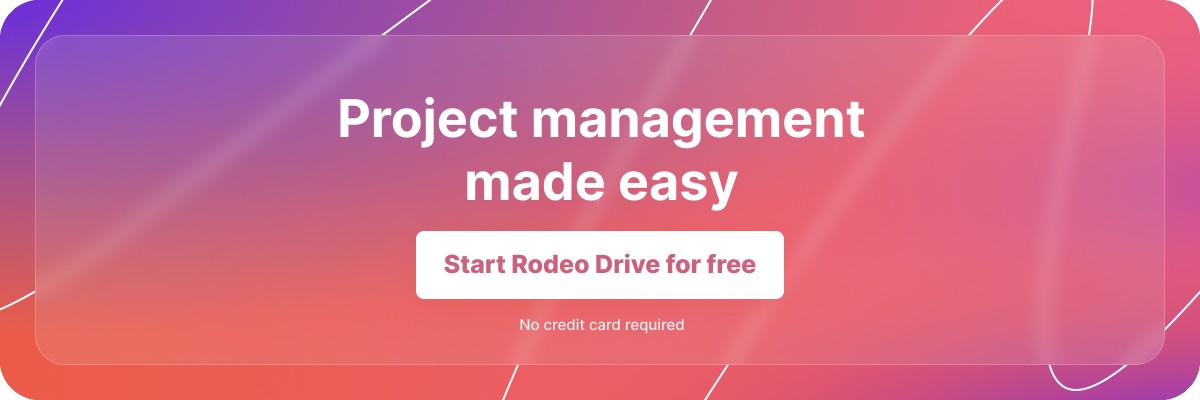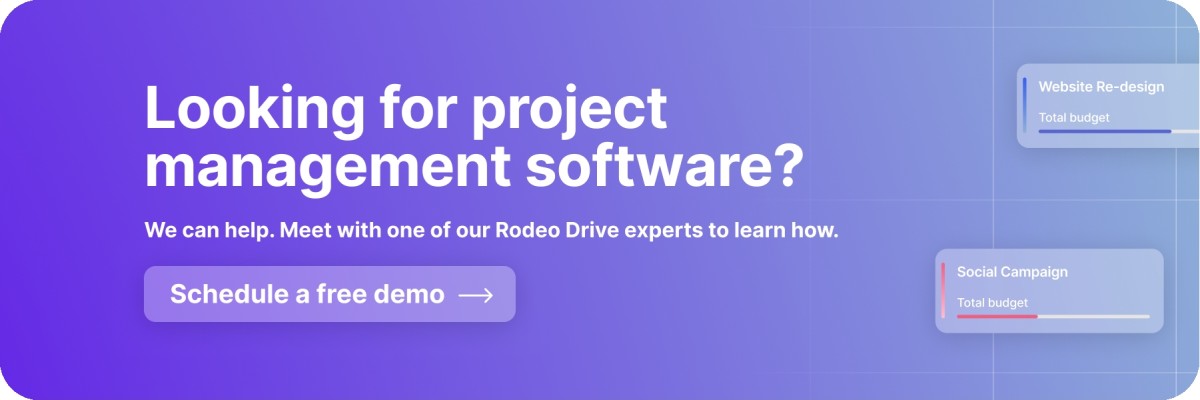How to Write a Statement of Work that Steers Projects to Success
Successful projects begin with clear intentions. A statement of work is a formal document in project management shared between a customer and a vendor — it clarifies the expectations, responsibilities, and obligations each party has to the other for the duration of a project.
As a legally binding agreement, a statement of work protects each party in the case of a dispute. In fact, a good statement of work reduces the likelihood of miscommunication or conflict, since provides transparency for the entire project.
Let’s discuss the elements of a strong statement of work, then dive into an example case to see how one functions in practice.
What’s a statement of work (SOW) in project management?
A statement of work is a detailed guide that outlines all aspects of a project. It provides both a client and service provider with clear instructions and expectations about a project.
A statement of work can cover everything from the specific tasks, project deliverables, and timeframes, to broader considerations like payment terms and legal requirements.
Clearly defining these elements in the statement of work prevents misunderstandings from happening once the project is underway, setting the stage for a successful project outcome.
Statement of work vs. scope statement
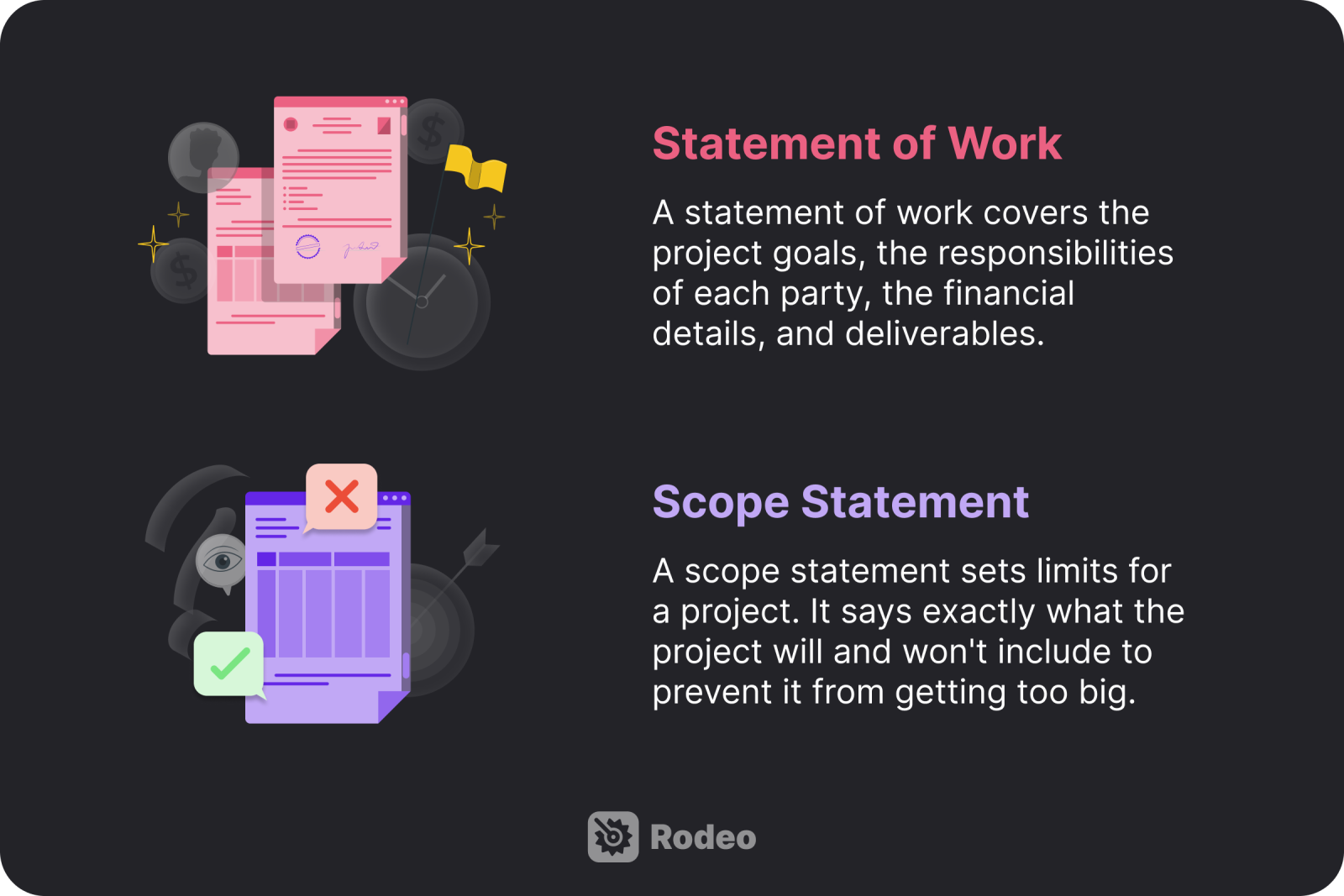
While they may seem similar, a statement of work (SOW) and a scope statement serve different, yet complementary functions in project management.
The statement of work covers all the how, when, and cost questions of a project. It is essentially a contract. It lays out work requirements and the obligations between the client and the service provider.
In contrast, the scope statement is a more focused, boundary-setting document. It’s the part of the project management plan that defines the scope — zeroing in on what will or won’t be included in the project, helping control scope creep.
The statement of work will usually be more of an external document, shared between the project client and the service provider, whereas the scope statement is more of an internal document used by the project manager and team to keep the project on track.
Together, these documents ensure everyone has a clear understanding of what the project entails and its constraints.
What’s included in a typical statement of work?
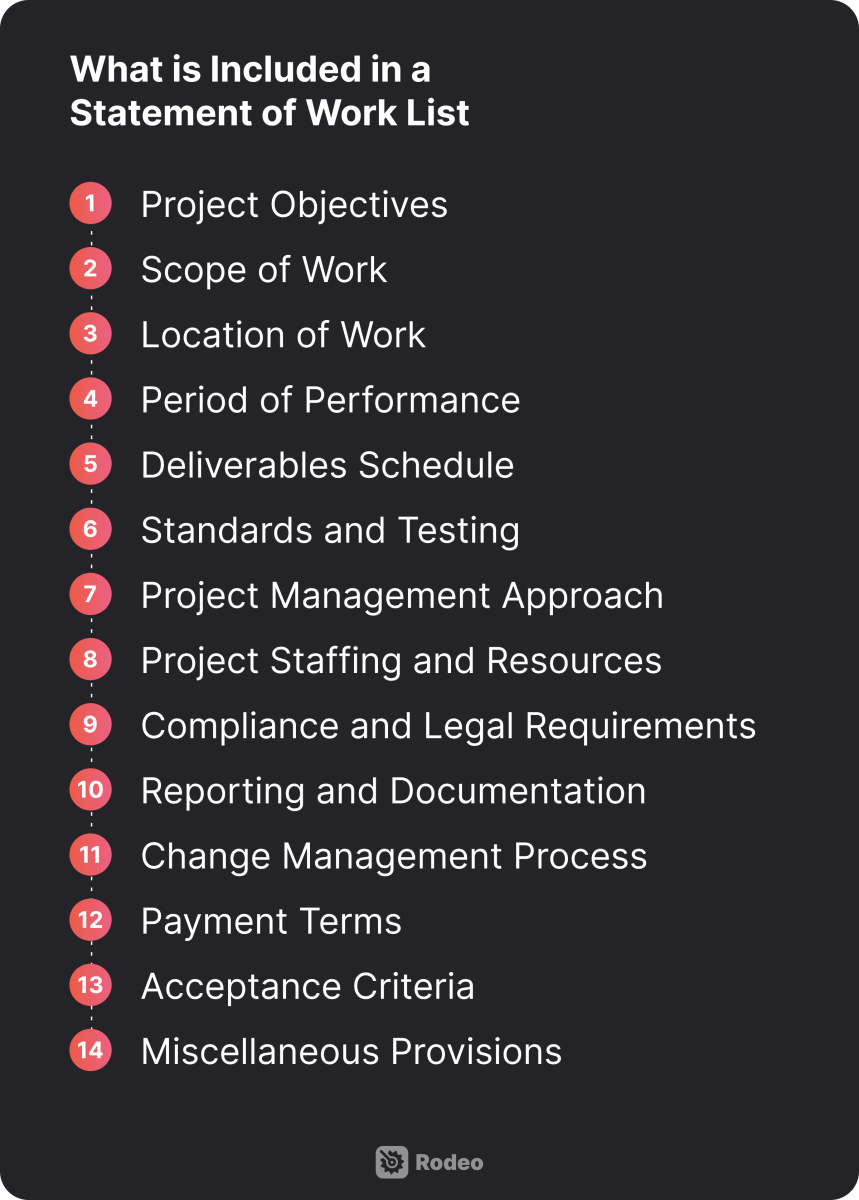
While it might be tempting to cut down bureaucracy and jump right into a project, proper project documentation streamlines communication with clients and controls for project risk.
It’s impractical to document everything — but including some documentation in your process will encourage decision-makers to closely evaluate project details and think ahead.
A statement of work can include more or fewer items depending on the nature of the project. Generally, though, a statement of work will always cover objectives, project deliverables, costs, and the acceptance criteria of a project. Let’s cover some of the more common elements in a statement of work.
Project Objectives
This section is the compass of the SOW, guiding the entire project. It is a purpose statement that outlines primary goals and objectives, providing a clear direction for what the project aims to achieve.
Whether it’s developing a new product, implementing a system, or completing a specific task, the project objectives section ensures that everyone’s efforts are aligned toward the same end goals.
Alongside the objectives, project leaders should choose key performance indicators that measure whether project teams are approaching those objectives.
Scope of work
The heart of the SOW, the scope of work section, details the specific tasks and deliverables expected from the project. It breaks down the project into manageable parts, outlining each step and its expected outcome.
Location of work
Where will the project take place? On-site at the client’s office? Remotely? Or a mix of both? This part of the SOW specifies the physical or virtual location of the work. It’s essential for logistical planning and resource allocation.
Depending on the project, this can be more or less relevant. For example, if the work requires infrastructure like a lab, or special equipment is needed, then location is something the statement of work should specify.
Period of performance
In project management, timing is everything. This section discusses the start and end dates of the project, providing a clear timeline for completion. It’s vital for scheduling and managing potential resource constraints, ensuring the project has the time and people it needs for successful completion.
Deliverables schedule
A project is typically divided into smaller, more manageable parts, which are known as deliverables. A statement of work should outline when each deliverable is due on the project timeline. This sets up clear expectations for progress reporting and assures the client that the project is moving forward as planned.
Standards and testing
This part of the SOW outlines the quality standards and testing procedures that the deliverables must adhere to. It defines what “good” looks like and sets the initial criteria for acceptance, ensuring that the final outputs meet the required quality benchmarks. Applying a benchmarking technique to the project result is a best practice here.
Project management approach
This part of the SOW outlines the methodology and strategies that will be used to manage the project. It covers aspects like project governance, risk management, communication plans, and resource management. Detailing the approach ensures that there is a clear understanding of how the project will be managed and what methodologies will be used to manage the project.
Project staffing and resources
This section specifies the resources allocated for the project. It includes details about the team composition, roles and responsibilities, and any specific qualifications or skills needed. It may also cover the equipment, technology, and other resources necessary to complete the project.
Compliance and legal requirements
Here, the SOW addresses any legal and regulatory compliance issues relevant to the project. It might include industry standards, legal requirements, and any permits or licenses that are necessary.
Reporting and documentation
This portion of the SOW specifies the performance reporting, including the frequency, format, and content of progress reports.
Change management process
In this section, the SOW outlines the procedures for handling changes to the project scope, schedule, or budget. It defines how change requests are made, evaluated, and approved. This is crucial for controlling scope changes and ensuring that any changes are systematic.
Payment terms
This section covers the financial aspects of the project, including the total cost, payment schedule, and billing process. It’s essential for managing budget plans and preventing disputes over money.
Acceptance criteria
Finally, the SOW should define the criteria for accepting the final deliverables of the project. This includes the specific conditions that must be met for the work to be considered complete and satisfactory.
Miscellaneous provisions
Every project is unique, and sometimes additional details need to be covered. This catch-all section can include anything from confidentiality clauses and intellectual property rights to dispute resolution mechanisms and termination conditions.
It’s the section for everything else that doesn’t neatly fit into the other categories but is still crucial for the project’s success.
The 3 key statement of work categories
There are different conventions for writing a statement of work. A project manager can pick and choose between them based on the nature of the projects in question and how people in their organization prefer to work.
Here are the types of statements of work:
Level of effort statement of work
The level of effort SOW is about flexibility. It’s used when the exact outcome of a project is not known, making it ideal for projects where the scope is not clearly defined, or where change is expected.
This type of SOW focuses on the effort and resources required rather than specific outcomes. It’s particularly useful in situations where the amount of work cannot be precisely estimated upfront.
Performance-based statement of work
The performance-based SOW is outcome-oriented. It focuses on what needs to be achieved but leaves the “how” to the service provider. This approach is preferred by many project managers because it offers flexibility in the method of achieving the project goals.
The performance-based approach encourages innovation and creativity in the approach to work, as long as the end goals are met. It specifies the purpose of the project without being overbearing about how the work should be executed.
Detail statement of work
Also known as a design SOW, this type is the most prescriptive. It’s highly detailed, specifying not just the outcomes but also how the work should be done.
This type of SOW is often used in projects where the method of execution is critical, such as in engineering or construction projects where adherence to specific processes and standards is essential.

Why choose one type of statement of work over another?
Choosing which type of SOW hinges on the requirements of the project. If you're venturing into a project with many unknowns or where requirements are expected to change, a level of effort SOW offers flexibility as the project progresses. It's perfect for innovative or exploratory projects where defining the end product from the start is challenging.
On the other hand, if your project has clear outcomes, but the path to achieving them is open for interpretation, a performance-based SOW is the way to go. This type encourages creativity, giving the project team the freedom to determine the best path toward results.
For projects where outcomes and methods are definite, a detailed SOW is a good choice. It leaves no room for ambiguity, ensuring the project adheres to predefined guidelines.
In essence, understanding your project's specific needs will help you create the right statement of work, leading to more successful outcomes.
Statement of work example
Let’s dive into an example case to understand how an effective SOW functions in practice. Imagine GlowCart, an emerging retail player looking to enhance its digital presence. They want to develop a custom mobile application to boost their online sales.
The challenge? They don’t have the technical expertise in-house, so they need to partner with a software development firm to develop the app. Of course, since the service provider isn’t immediately familiar with GlowCart’s brand vision and customer preferences, they’ll need some guidance to deliver an app that meets the project’s objectives.
The SOW in this scenario becomes the guide for GlowCart’s project stakeholders and the external development team as they move through each stage of the project. Here’s how they can structure it:

Defining project objectives
The first thing GlowCart needs to communicate is the objectives of the project. They should write what they want the project to achieve.
A good structure is to write a qualitative goal and quantitative objectives. This means they should write the project’s overall goals in words, and then break them down into objectives that are measurable in numbers.
Goals: To design and develop a user-friendly mobile application that enhances the customer shopping experience, increases online sales, and integrates with their current inventory system.
Objectives: Increase online sales by 20% within the first six months of launch and achieve a user satisfaction rate of at least 85%.
Scope of work
Next, GlowCart should list all the stages of the project, plus what they expect to be delivered at the end of every stage.
Project stages: Conduct user research, design UI/UX, develop an application for iOS and Android, integrate with the existing inventory system, test the application, and launch.
Deliverables: Research report, design mockups, beta version of app, final app version, integration construction, test cases and results, launch plan, app rollout.
Location of work
Since GlowCart is working with an external development team, this could mean highlighting where and how frequently they should meet to discuss project progress.
Maybe the external team operates remotely, but they meet with a GlowCart team on video once a week. Or perhaps after key milestones are completed, GlowCart and the development team meet in person to determine the next steps.
Period of performance
The development team might structure the start and the end date of this project to account for existing commitments and their team capacity.
For GlowCart, understanding the period of performance sets expectations for the project timeline. It also helps with coordinating other teams running adjacent to the project — for example, it might help determine when and how an internal marketing or design team should schedule their related activities.
- Start Date: March 1, 2024
- End Date: September 30, 2024
Deliverable schedule
The deliverable schedule expands on the period of performance. It highlights deadlines for achieving specific phases of the project. For this project, it might look something like this:
- Research Report: April 15, 2024
- Design Mockups: May 10, 2024
- Beta Version: June 20, 2024
- Final App Version: August 10, 2024
- Integration Report: August 25, 2024
- Test Cases and Results: September 5, 2024
- Launch Plan: September 20, 2024
Standards and Testing
GlowCart will need to include their criteria for the project’s success and what testing they expect the development team to perform.
- The app must meet GlowCart's brand guidelines, be user-friendly, and be functionally robust.
- Rigorous testing for bugs, compatibility (iOS and Android), and user experience.
Payments terms
The payment terms highlight when invoices should be paid along the project schedule. Project management software can then be used to set up automated invoicing along that schedule. This section will also include the overall budget of the project and itemized costs.
- Total Project Cost: $100,000
- Payment Schedule: 30% upfront, 30% after beta version delivery, 40% upon project completion.
Project management approaches
This section highlights how project work will be performed. GlowCart may include expectations for how project communication is structured, while the development team will lay out how they intend to structure project work.
- Agile methodology with bi-weekly sprints
- Share sprint plans so GlowCart can be keyed into development progress
- Regular stakeholder meetings for updates and feedback
Project staffing and resources
In the staffing and resources section, the parties agree to resource allocation for the project and the expected utilization of personnel.
- Project Team: 2 UI/UX designers, 3 developers, 1 digital project manager, 1 QA tester
- Resources: Software development tools, testing platforms, communication tools
Compliance and legal requirements
In this section, both parties will highlight compliance needs and potential legal considerations that the project and final product must follow.
- The app must comply with data protection laws and e-commerce regulations
- Necessary certifications for software and data security standards
Reporting and documentation
Here, the parties will agree to the reports the development team needs to produce. GlowCart might also ask for documentation on the code and set parameters for what testing reports should look like.
- Bi-weekly progress reports to GlowCart
- Documentation of all stages of development and testing
Change management process
Should the project team need to enact a contingency plan, having a change management process included in the statement of work can prevent the client from being caught off guard.
Maybe GlowCart and the development company appoint a joint something like a joint change control board, with managers from both organizations responsible for collaborating on decisions when the project needs to be changed. Or the process could look like this:
- All change requests must be submitted in writing and approved by both the project manager and GlowCart
- Impact analysis is to be conducted for each change request
Miscellaneous provisions
This is a section for any other provisions of the project. Since this project involves proprietary technology, GlowCart needs to ensure that the new app fully belongs to them. So at the end of the statement of work, they will include clauses specifying:
- Confidentiality: All data and findings are proprietary to GlowCart
- Intellectual property: All app designs and code will be the property of GlowCart
Acceptance criteria
That acceptance is contingent on GlowCart’s confirmation that the app meets all outlined objectives, passes all tests, and integrates seamlessly with its inventory system.
Easily monitor your statement of work execution with Rodeo Drive
While a statement of work sets the stage for a successful project, execution still matters. Project management tools like Rodeo Drive simplify the work of monitoring the elements outlined in your SOW documents.
You can use Rodeo Drive to plan project phases and deliverables, understand whether the scope outlined in the SOW is realistic given active time constraints, and finally manage the budget plan outlined in your SOW.
Here’s how Rodeo Drive helps projects stay healthy and on course:
Easily send straightforward budget estimates to clients
Trust is the cornerstone of lasting client relationships. You’ll want to make sure the client feels as though your team is bringing sufficient value to the project.
That’s why Rodeo Drive helps you build trust with your clients from the very beginning of your project. As soon as you build a budget in Rodeo Drive, you can send that budget to your client as an estimate straight from the platform.
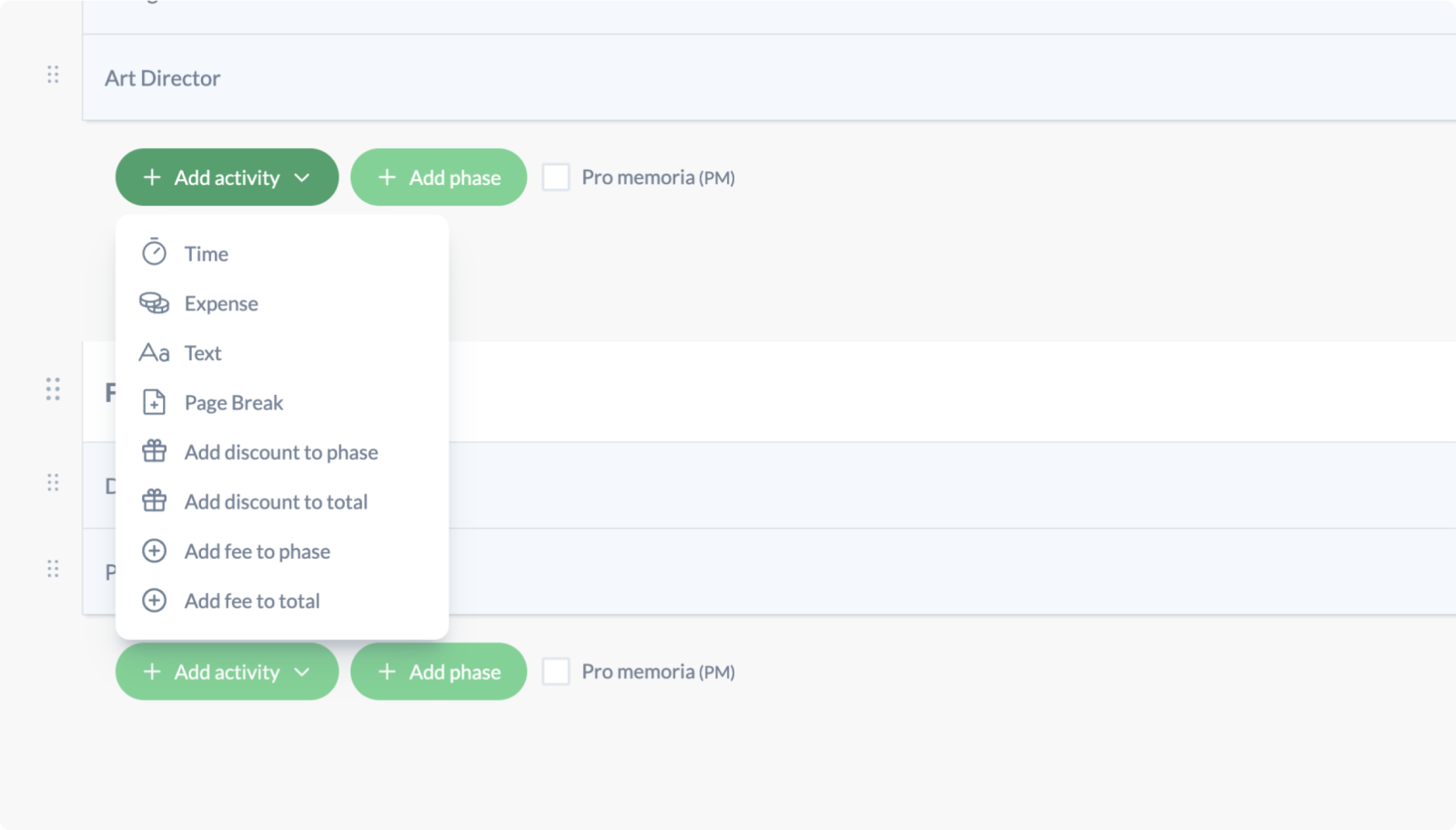
Create client-ready budget estimates in Rodeo Drive in just a few clicks
All estimates and invoices sent from Rodeo Drive are fully customizable, meaning you’re free to choose which information gets included on your estimates and add discounts, terms and conditions, or personalized notes.
This way, you can start building your client’s trust with a transparent look at what the project will cost from the very beginning.
Share timelines with free guest user access
Efficient project management hinges on a shared understanding of timelines. Rodeo Drive keeps all your project timelines centralized and organized in your Planner tab.
Rodeo Drive’s Planner is designed to give you a clear understanding of which project activities are scheduled and when. Its timeline-view design also allows you to see the different phases of your ongoing projects at a glance, which helps prevent scheduling conflicts when you’re assigning project activities to team members.
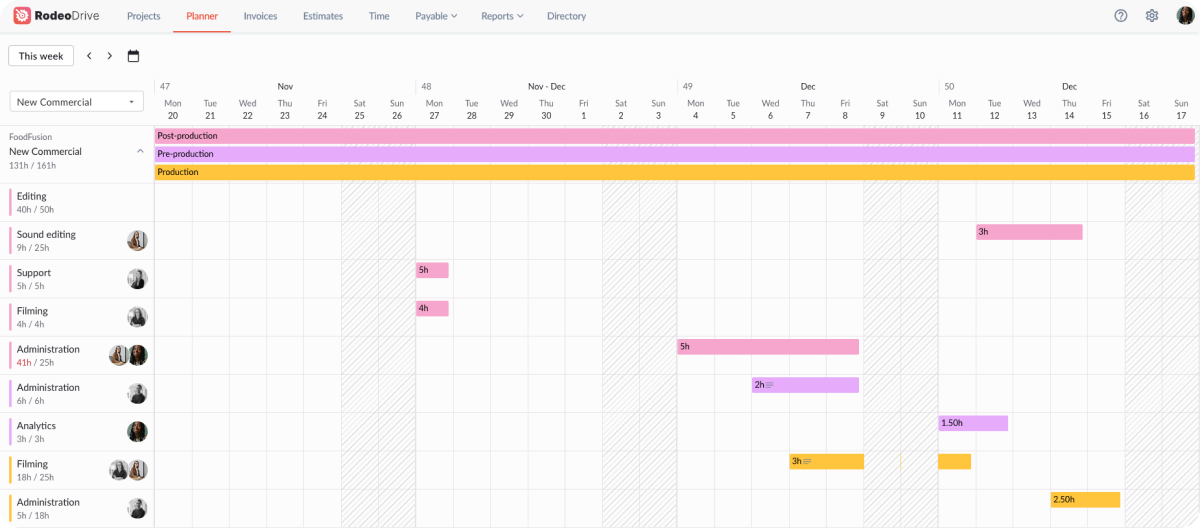
Create visual project timelines in Rodeo Drive
Plus, Rodeo Drive offers unlimited guest access. This means clients can be looped in to see where the project is up to — without having to constantly ask for updates.
Keep your purchase orders organized
If the project requires third-party vendors outside of the parties in the statement of work, documenting purchase orders and other financial records is invaluable. This ensures all expenses are in line with the budget projections agreed to in the statement of work.
In Rodeo Drive, you can create purchase orders within the project budget and export them into PDFs to ensure proper documentation.
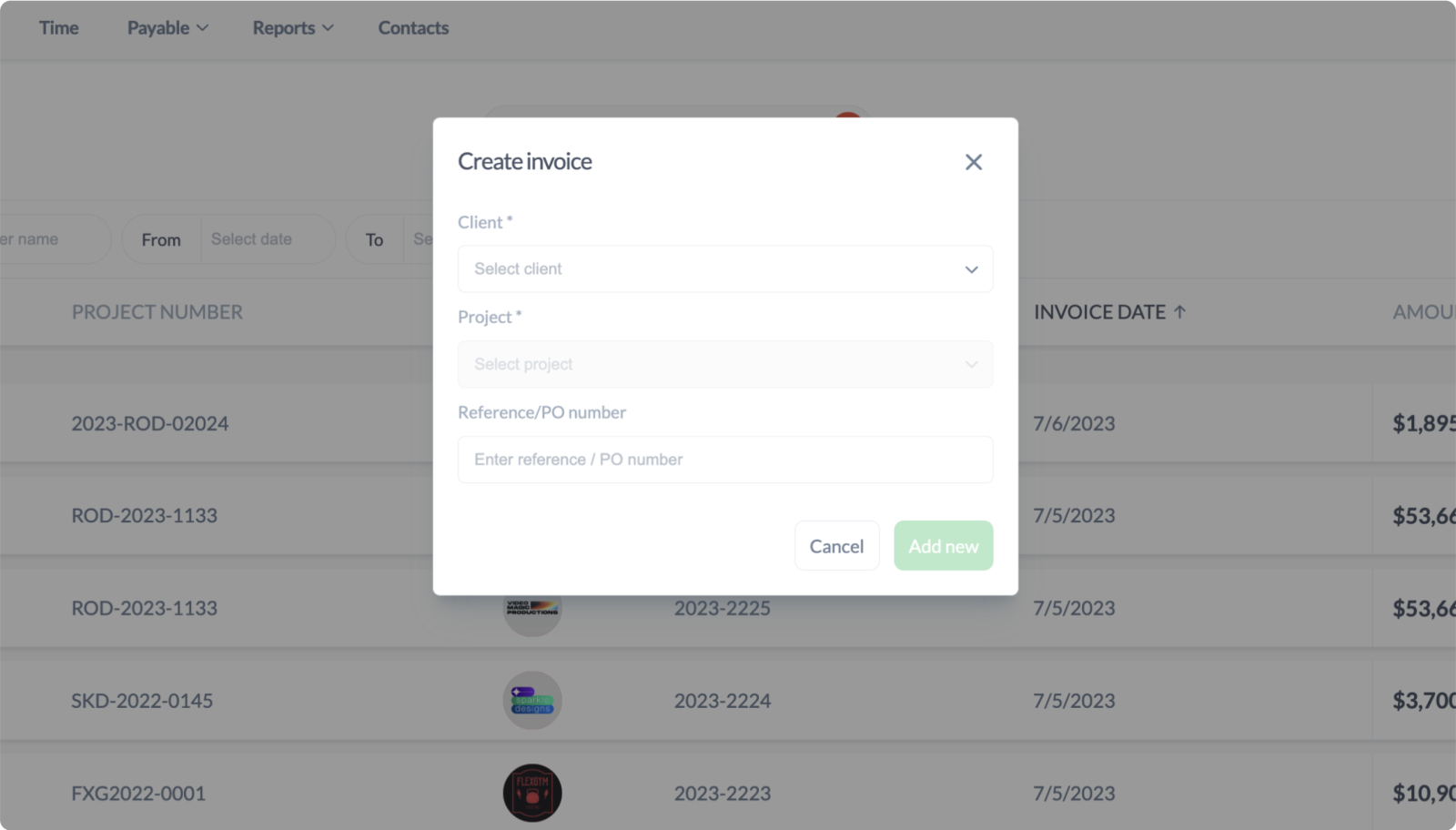
Create, send, and document Purchase Orders with Rodeo Drive
These features help project teams deliver great work to clients, on time and within budget.
It’s one thing to just hear about it though. Come see for yourself — start a free trial of Rodeo Drive, and turn a statement of work into reality.





